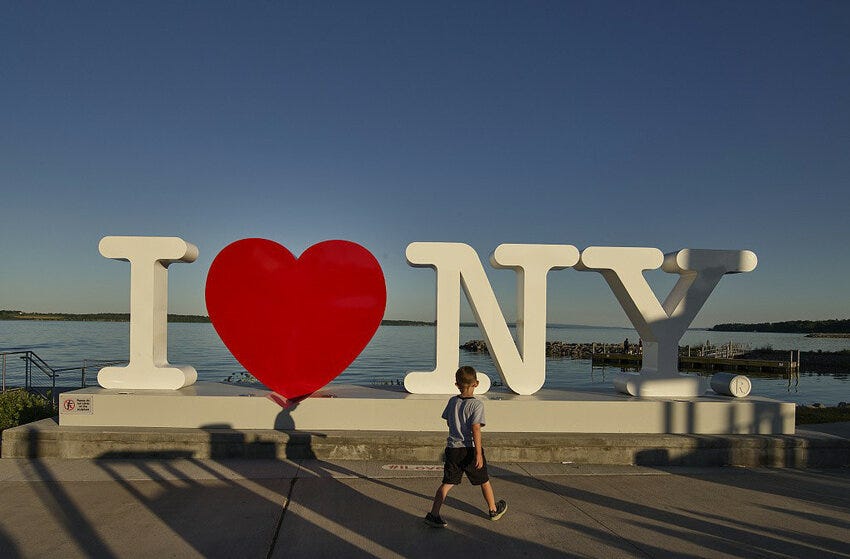Symbols as rallying points around the commons
Urban symbols are governance – visible manifestations of how communities negotiate meaning in shared space. When a city's residents converge around an icon, they're practicing commons stewardship.
A child walks past the iconic “I ♥ NY” sign—a gesture of urban branding that Milton Glaser designed in the 1980s to revitalize the city’s image. Today, this symbol carries a different weight. It has become a rallying point, a declaration of values, a form of resistance through affirmation.
A fascinating research paper by Morteza Hemmati examines how linguistic signs in urban landscapes shape collective memory and identity. Hemmati argues that these symbols—whether ancient calligraphy on Persian architecture or modern emoji sculptures in public squares—represent more than wayfinding or branding. They are mechanisms through which communities negotiate meaning, assert identity, and exercise collective agency over shared space. That is definitely something that I will use in future classes about brands and branding, in order to show my students how brands are complete entities representing all the facets of a business, integrating its people, its partners, its clients, its ethics (a.k.a. practices, not just words on mugs) and its values. They are not logos or shallow visuals. They carry meaning and represent a contract between those who care about the symbol, which embodies the commons that belong to all the members of the community.
This observation opens a crucial question about the governance of our commons—not just the physical spaces we share, but the symbolic commons that give them meaning. When a city’s residents converge around a symbol, they are essentially performing an act of commons governance: defining boundaries, establishing rules, monitoring compliance, and sanctioning violations. These are precisely the design principles Elinor Ostrom identified in successful commons regimes.
But here’s the paradox: while we’ve become sophisticated at understanding how to govern tangible commons, such as forests, fisheries, irrigation systems, even though we still tend to only see them as either private or in the hands of government, we’re only beginning to grapple with how to govern symbolic and digital commons. How do communities maintain their right to define what their shared spaces mean? Who decides which symbols occupy the most influential locations in our urban landscapes? Who has the rights to them and what is the appropriation of value from physical space?
The stakes extend far beyond aesthetics. As we confront planetary boundaries that require unprecedented collective action, our capacity to create and defend shared meaning-making spaces becomes existential infrastructure. Climate adaptation, democratic resilience, and social cohesion all depend on communities’ ability to assert collective identity and purpose through their commons—both physical and symbolic.
The article notes how simplified, media-driven symbols (emojis, hashtags, imported branding formulas) have displaced more complex, culturally-rooted expressions in urban landscapes. This isn’t merely aesthetic loss—it’s a degradation of the commons’ capacity to support the rich, contextual meaning-making that diverse communities require.
When New Yorkers gather around their city’s iconic symbol today, they’re not just expressing local pride. They’re demonstrating something fundamental about commons governance: that those who inhabit shared spaces retain the authority to define what those spaces represent. That legitimacy flows from participation, not imposition. That symbols in public spaces belong to publics—not to transient authority.
This matters because every major challenge we face—from climate to governance to digital transformation—requires us to act collectively while respecting diversity. We need institutional frameworks that can hold both coherent shared purpose AND legitimate dissent. We need commons that can support both belonging AND contestation.
The urban landscape, with its symbols and signs, is where we practice this daily. It’s where abstract principles of commons governance become concrete, visible, lived. It’s where we learn—or fail to learn—how to steward shared resources while honoring the plural meanings different communities bring to them.
Perhaps that’s why a simple sign saying “I ♥ NY” can carry such weight: it reminds us that the commons is not just what we share, but how we choose to govern what we share. And that choice remains ours to make.


